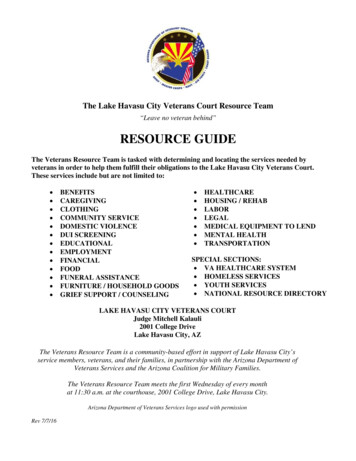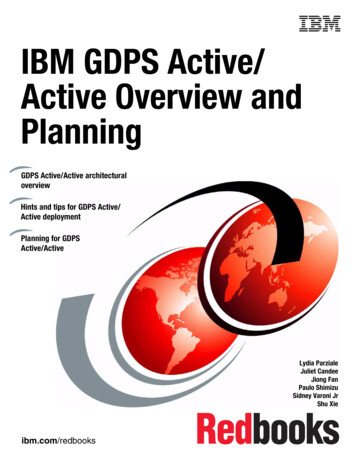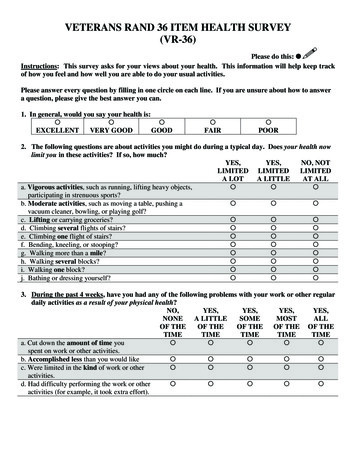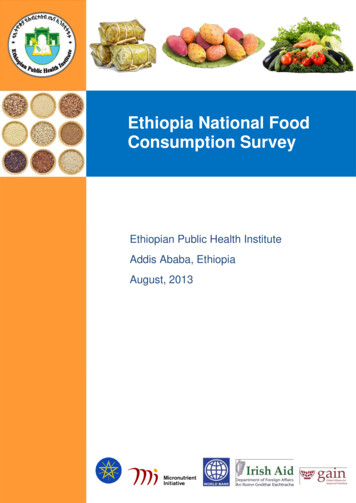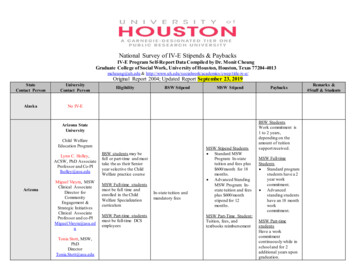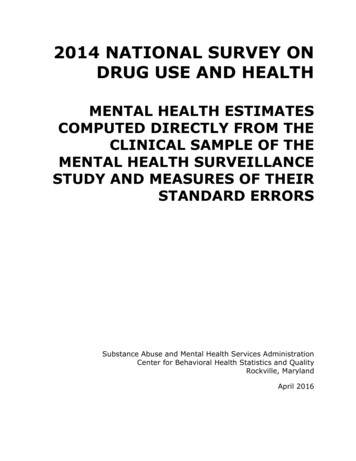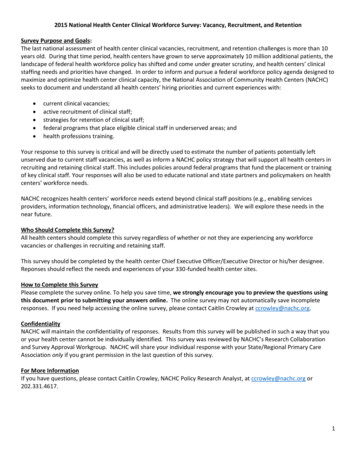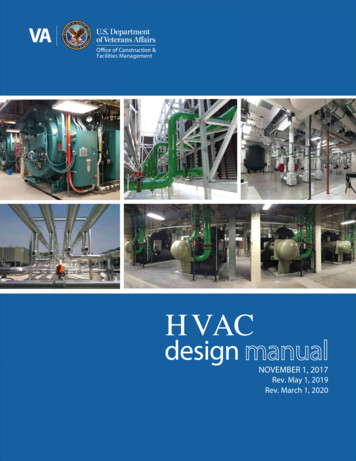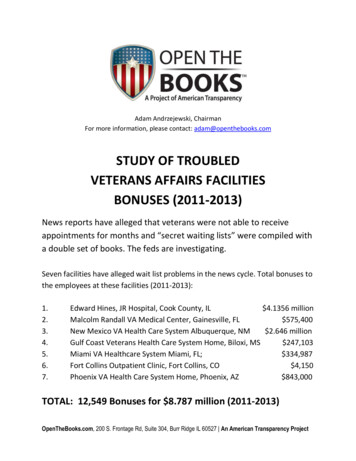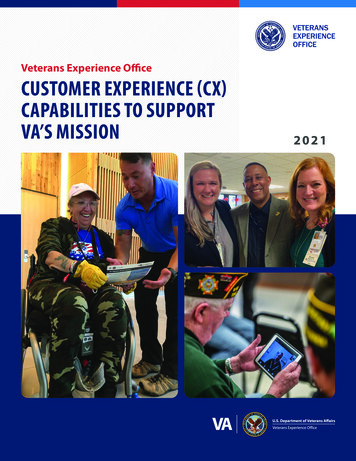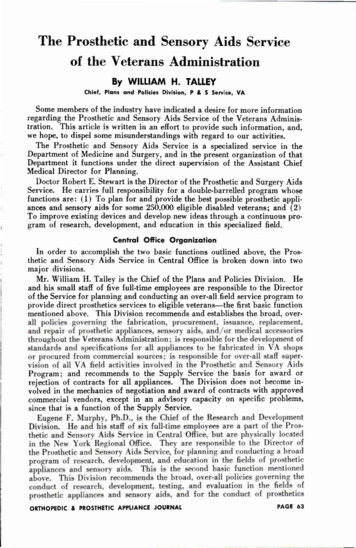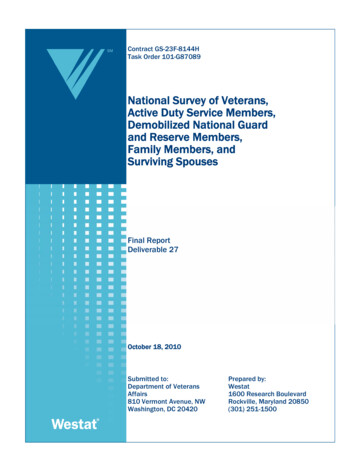
Transcription
Contract GS-23F-8144HTask Order 101-G87089National Survey of Veterans,Active Duty Service Members,Demobilized National Guardand Reserve Members,Family Members, andSurviving SpousesFinal ReportDeliverable 27October 18, 2010Submitted to:Department of VeteransAffairs810 Vermont Avenue, NWWashington, DC 20420Prepared by:Westat1600 Research BoulevardRockville, Maryland 20850(301) 251-1500
AcknowledgementsDuring the course of a survey, many people contribute to its design and implementation. Wegratefully acknowledge all involved in this effort, from those providing valuable content guidance atVA, to those providing technical advice at Westat, to those receipting and checking the returnedsurveys. Although there are many individuals deserving mention, the contributions of the followingindividuals are particularly appreciated First we thank Assistant Secretary for Policy and Planning, Dr. Raul Perea-Henze for his overallleadership and support. We thank Maribel Aponte, Project Officer for the U.S. Department ofVeterans Affairs (VA), for her leadership and support in the design and implementation of the 2010National Survey of Veterans (NSV). We further thank Laura O’Shea, Angus St. Hilaire, and CathyManga of the VA for the contribution of their valuable expertise to this effort. We would also like tothank Scott Seggerman, Colin Rogers and Dr. Robert Simmons at the Defense Manpower DataCenter (DMDC) who were generous with their time and support of this VA effort.We also thank VA staff from the National Cemetery Administration, the Veterans BenefitsAdministration, and the Veterans Health Administration for their support. We also thank the Officeof Management and Budget for its valuable contribution to the NSV project.At Westat we thank John Helmick and Wayne Hintze for their leadership and we thank Bob Fay,Richard Sigman, Marianne Winglee, and Daifeng Han for contributing their remarkable statisticalexpertise to this survey. Bryan Davis and Don Vicars were instrumental in assuring data security andDavid Cantor, Pat Dean Brick, Pamela Giambo, and Michele Harmon provided invaluablemethodological expertise. We thank Reina Sprankle for her strong leadership in the data collectionoperations and we also thank her incredible team of data preparation specialists. We thank LindaLibeg, Yunhee Lim, Andrew Heller, and Theresa Famolaro of Westat for their programmingexpertise and oversight.Contributing authors to this report included: Maribel Aponte of the VA; and Pamela Giambo, JohnHelmick, Wayne Hintze, Richard Sigman, Marianne Winglee, Debra Dean, Sushama Rajapaksa,Matthew Ragan, Christopher Shumway and Christopher Manglitz of Westat.Analysts contributing to this report included: Pamela Giambo, Jennifer Kawata, Mary Ann Deak,Sushama Rajapaksa, Rose Windle, and Swati Nadkarni of Westat.National Survey of Veterans — Final Reporti
And most important, we thank the survey respondents who took the time to contribute to thisimportant research effort. We also thank them and their families for their contributions to ourcountry.iiNational Survey of Veterans — Final Report
Table of ContentsAcknowledgements . iTable of Contents . iiiList of Acronyms . viExecutive Summary. viiiIntroduction . 11.1The National Survey of Veterans . 11.2The 2010 National Survey of Veterans . 21.3Use of This Report . 41.4Organization of the Report . 4Study Methodology . 62.1Questionnaire Design . 62.2Sample Design . 102.2.1List-Based Samples . 122.2.2Address-Based Samples . 132.3Data Collection Operations . 162.3.1Data Collection Methods Used for AddressFrame Sample Members . 162.3.2Data Collection Methods Used for List-FrameSample Members . 212.3.3 Telephone Surveys . 252.3.4 Survey Support Center . 252.3.5 Receipt Control Operations . 262.3.6 Weekly Status Reports on Survey Administration . 262.3.7 Processing of Paper Surveys. 262.4Weighting Procedures . 282.4.1Introduction . 282.4.2Nonresponse bias analysis and adjustments . 282.4.3Final weights . 302.4.4Variance estimates . 332.4.5Data validity and limitations. 342.4.6Response and Coverage Rates . 342.5Recommendations for Further Inquiry . 45Analysis . 473.1Data Editing . 473.2Analyzed Surveys . 49Survey Results . 504.1Veterans . 514.1.1Demographics and Military Service Experience . 534.1.2Awareness and Outreach . 744.1.3Transition Assistance . 1034.1.4Disability and Vocational Rehabilitation . 1064.1.5Health Status . 117National Survey of Veterans — Final Reportiii
4.24.34.44.54.1.6Health Care . 1224.1.7Health Insurance . 1374.1.8Education and Training . 1444.1.9Military Service and Current Employment . 1544.1.10 Life Insurance. 1614.1.11 Home Loans . 1654.1.12 Burial. 170Demobilized National Guard and Reserve Members . 1814.2.1Demographics and Military Service Experience . 1814.2.2Awareness and Outreach . 1904.2.3Transition Assistance . 1974.2.4Disability and Vocational Rehabilitation . 2004.2.5Health Status . 2074.2.6Health Care . 2104.2.7Health Insurance . 2204.2.8Education and Training . 2244.2.9Military Service and Current Employment . 2294.2.10 Life Insurance. 2344.2.11 Home Loans . 2364.2.12 Burial. 240Active Duty Service Members . 2484.3.1Demographics and Military Service Experience . 2484.3.2Awareness and Outreach . 2534.3.3Health Status . 2634.3.4Education and Training . 2654.3.5Life Insurance. 2684.3.6Home Loans . 2694.3.7Burial. 272Veteran Spouses, Active Duty Spouses, and SurvivingSpouses . 2794.4.1Spouse Demographics and Military ServiceExperience . 2794.4.2Awareness and Outreach . 2894.4.3Disability . 2984.4.4Health Status and Insurance . 3004.4.5Education and Training . 3024.4.6Home Loans . 3054.4.7Burial. 309Patterns in Awareness/Understanding of VA Benefits . 317ivNational Survey of Veterans — Final Report
List of AppendicesAppendix A – National Survey of Veterans Questionnaire Instrument . A1Veterans Survey . A2Demobilized National Guard and Reserve Member Survey . A26Active Duty Service Member Survey . A54Veteran Spouse Survey . A66Active Duty Spouse Survey . A82Surviving Spouse Survey . A94Appendix B – National Survey of Veterans Detailed Description ofWeighting Procedures . B1Appendix C – National Survey of Veterans Caveats on Data Comparisons . C1Appendix D – Detailed Data Tables .D1Veterans Survey Tables .D2Demobilized National Guard and Reserve Member Survey Tables . D178Active Duty Service Member Survey Tables . D248Veteran Spouse Survey Tables . D276Active Duty Spouse Survey Tables . D305Surviving Spouse Survey Tables . D325National Survey of Veterans — Final Reportv
List of MRP.L.PITEPOWPSMAFsRDDAddress-Based SamplingAmerican Community SurveyActivity of Daily LivingActive Duty Service MemberAssistant Deputy Under Secretary for HealthComputer-Assisted Telephone InterviewingComputerized Delivery SequenceCommunity Homelessness Assessment, Local Education and Networking GroupsCivilian Health and Medical Program of the Uniformed ServicesCivilian Health and Medical Program of the Department of Veterans AffairsCertificate of EligibilityCommercial Off-The-ShelfDependents’ Educational AssistanceDefense Enrollment Eligibility Reporting SystemDependency and Indemnity CompensationDefense Manpower Data CenterDepartment of DefenseDelivery Sequence FileDisabled Transition Assistance ProgramEmployment History SurveyFederal Housing AdministrationFamily Servicemembers’ Group Life InsuranceHousing and Urban DevelopmentIntelligent Character RecognitionList-based samplingMedical Expenditure Panel SurveyMontgomery GI BillMontgomery GI Bill - Selected ReserveMarketing Systems GroupNational Cemetery AdministrationNational Guard/Reserve ComponentNursing Home ComponentNational Survey of VeteransOptical Character RecognitionOperation Enduring FreedomOperation Iraqi FreedomOffice of Management and BudgetOptical Mark RecognitionPublic LawPoint-In-Time ExtractPrisoner Of WarPrior Service Military Address FilesRandom-Digit-DialviNational Survey of Veterans — Final Report
VBAVGLIVHAVR&EWWIIReserve Education Assistance ProgramStatistical Analysis SoftwareService-Disabled Veterans’ InsuranceServicemembers’ Group Life InsuranceSurvey Management SystemStructured Query LanguageTransition Assistance AdvisorTransition Assistance ProgramServicemembers’ Group Life Insurance Traumatic Injury ProtectionUniformed Services Employment and Reemployment Rights ActU.S. Postal ServiceU.S. Department of Veterans AffairsVA/DoD Identity RepositoryVeterans Benefits AdministrationVeterans’ Group Life InsuranceVeterans Health AdministrationVocational Rehabilitation and EmploymentWorld War IINational Survey of Veterans — Final Reportvii
Executive SummaryThe 2010 National Survey of Veterans (NSV) is the sixth in a series of comprehensive nationwidesurveys designed to help the Department of Veterans Affairs (VA) plan its future programs andservices for Veterans. The information gathered through these surveys will help VA to identify theneeds of Veterans and then allocate resources in ways that will ensure these needs can be met.While past NSVs have been conducted under the general authorization of U.S. Code Title 38,Section 527 which requires the VA Secretary to gather data for the purposes of planning andevaluating VA programs, the 2010 NSV also included the requirement, at the direction of P.L. 108454, Section 805, to assess beneficiary awareness of VA benefits and services. The Public Law alsoexpanded the survey populations in the 2010 NSV to include in addition to Veterans, otherbeneficiary groups: Active Duty Service members; demobilized National Guard and Reservemembers; Family members and Surviving spouses. Westat, under contract to VA, conducted the2010 NSV.Study ObjectivesThe NSV was conducted to obtain information VA may use in planning and allocating resources forprograms and services for Veterans. It also provides a snapshot profile of the Veteran population.Data collected through the NSV enables VA to: follow changing trends in the Veteran population;compare characteristics of Veterans who use VA benefits and services with those of Veterans whodo not; study VA’s role in the delivery of all benefits and services that Veterans receive; and updateinformation about Veterans to help the Department develop its policies.In addition, and because understanding Veteran awareness of benefits and services has always beenan important VA goal, a major objective of the sixth NSV was to assess awareness of benefits andservices and understanding among Veterans and other stakeholder groups.Survey DesignThe scope of the 2010 NSV was expanded to cover additional target populations, as described byP.L. 108-454, Section 805. In addition, the 2010 surveys focused more sharply on awareness ofVeteran benefits and services, communication preferences (to improve outreach to VAbeneficiaries), and future plans for use of benefits and services. There were a total of six surveys,viiiNational Survey of Veterans — Final Report
each matching a particular population of interest: Veterans; Active Duty Service members; ActiveDuty spouses; demobilized National Guard and Reserve members; Veteran spouses; and Survivingspouses. Overall, survey items were developed for 19 questionnaire sections covering such areas asmilitary background, socio-demographic information, and the awareness and use of various VAbenefits and services. While a general goal was to maintain survey item consistency across the sixsurveys, not all sections pertain to all survey populations and the number of questions within asection varied across the survey populations. Finally, the wording in some of the questions wasadapted to fit the needs of the particular target population better (for example, questions of a spousemay have been worded differently from those posed to a Veteran).Study MethodologyThe 2010 NSV was conducted using a mailed, self-administered questionnaire. There were twosampling approaches: address-based sampling (ABS) and list-based sampling. Veterans, Veteranspouses and Surviving spouses were sampled using the ABS approach. The rationale is that there areno complete sampling frames available for these populations at VA or at the Department ofDefense (DoD). The Active Duty Service members, Active Duty spouses, and demobilized NationalGuard and Reserve members were sampled using lists provided by the DoD Defense ManpowerData Center (DMDC).Data collection began October 16, 2009, and ended March 19, 2010. We used two data collectionmethods or approaches, one for the address-based sample group and one for the list-based samplegroup, to collect the 2010 NSV data. Procedures for the address frame included two phases of datacollection. First, after sending pre-notification letters, a short (screening) survey was sent to eachsampled address. Information collected on the screener was used to sample or subsamplehouseholds at the second phase and to identify which of the eligible sample members would be inthe mail or web survey populations. Veteran households were not subsampled. Members of othersegments were subsampled and only members of the subsample received an extended survey.Because names and addresses were received for the list-based sample members, they wereapproached through a series of personally addressed contact letters and reminders. All contactedrespondents, both address-based and list-based, were offered the option to complete the survey viathe web.A total of 10,972 surveys were completed across the various survey populations of interest. Therewere 8,710 completed surveys received from Veterans. The response rate for the householdscreening survey was 32.3 percent; the response rate for the Veteran Survey was 66.7 percent, for anNational Survey of Veterans — Final Reportix
overall response rate of 21.5 percent. The response rate describes how households that both containand do not contain a Veteran responded to the survey. The effective coverage rate (ECR) is anestimate of the percentage of Veterans who responded to the survey; the estimated ECR for theVeterans Survey was 38.8 percent.Survey data were weighted to represent the entire non-institutionalized Veteran population. Weightsincorporated the probability of selection, survey nonresponse, and were post-strati
VGLI Veterans’ Group Life Insurance . VHA Veterans Health Administration . VR&E Vocational Rehabilitation and Employment . WWII World War II . National Survey of Veterans — Final Report vii. Executive Summary . The 2010 National Survey of Veterans (
